The Bagpipe Society
The Muzelzak - Muchosa - Part 2
Part 1 (Summer 2023) looked at the history of the instrument, Part 2 investigates the players and the search for original instruments.*
Pierre-François Muselet, (1835-1915) piposá player near Boulogne
I got to know Patrice Gilbert as a hurdy-gurdy player in the early 1980s when we went dancing every month in Lille with a delegation from Bruges. A musician of the folk revival, and a loyal visitor to festivals where hurdy-gurdy and bagpipes made their timid appearance, he only found out years later that among his ancestors, he had a traditional bagpiper. His great-great-grandfather on his mother's side, Pierre François Muselet. It turned out that he worked as a shepherd in the Boulogne area around 1860 and, as befitted a shepherd of the time, he also played the bagpipes - piposá, as Patrice's great-aunt remembered it.
His grandfather, on the other hand, called it a biniou. This Breton term has recently become more widely used in French to refer to bagpipes. The instrument itself has disappeared but stories in Patrice's family confirm the practice of the piposá in the Boulonnais and its connection to the pastoral profession.
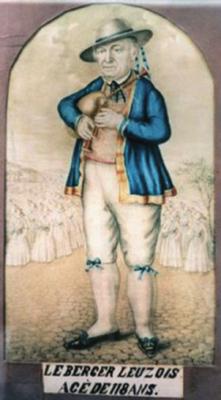
Pierre-François Muselet was born in Equihen (then Outreau) on 23 November 1835. During his lifetime he practiced many trades, not consecutively, but simultaneously, depending on the season and the occasion. He was a shepherd on a farm with sheep near the junction between Outreau and Le Portel.
He could also shear sheep and offered his services on many farms, as far as the Liane. One day, on his way back from shearing, he even fell into the river. This anecdote was told in a sober tone that suggested our shepherd was not entirely sober. His main profession was shoemaker and he offered his services everywhere. He could also reupholster chairs and occasionally, in winter, went out to sea to fish herring. During 35 of the last years of his life, he also worked as a gravedigger. But when he was a shepherd, around 1860, he played piposá and this included playing during midnight mass with other shepherds. In a tobacco shop-café on the Place d'Equihen, run by a certain Fourquet, Pierre-François Muselet would often go and play in exchange for a drink. This was not appreciated by his wife, so much so that one day, she got fed up with these drunks and pierced the pocket of his bagpipe so that the café visits would stop.
She made him believe it had been a mouse that had made the hole. As a shoemaker, he could have repaired the leather sack, but he chose to stop playing to keep the peace.
Le Berger Leuzois, Agé de 118 ans
In Leuze-en-Hainaut, a few decades ago, this lithograph from 1830
turned up at a photographer’s shop. We see a man, in his fifties, with an instrument that looks like a muzelzak, as already described in Part I. The inscription, Le Berger Leuzois, Agé de 118 ans, was added later, at least after 1885. It is said to refer to shepherd François Henniquiau. The shepherd had his sheephold at Pipaix, borough of Leuze-en-Hainaut. Hubert Boone mentions in his book Doedelzaktraditie in België that Henniquiau is said to be of Breton origin. that might not be quite correct. Searching for the name in genealogical internet sites, we find this surname only in a very small area around Leuze and Ath, and a few more in northern France, but not at all in Brittany. The confusion is more on the name of the instrument.
Although in the Leuze-Ath region the muzelzak was known by the Walloon-Picardian name muchosá or muchafou, the instrument is very often named by the Breton word biniou, which is the commonly known alternate word, other than ‘cornemuse’ for bagpipe throughout the French language area.
According to the same genealogical internet sites, shepherd François Henniquiau is said to have been born in 1780. The lithograph is associated with the millennium celebration of Canon Saint-Badilon in 1885. Possibly the shepherd was still alive then. Whether he would have lived another 13 years after that, until 118, as the inscription would have us believe, is unlikely. Nevertheless, Noel Demey from Bruges in his blogspot Belgian Super Centenarians mentions a shepherd in the Luxembourg Ardennes, Hubert Fairon, who attended another meeting of shepherds at the age of 118. He died aged 120. A healthy profession, clearly.
The Muchards of Northern Hainaut
Until World War I, most of the villages on the Walloon banks of the Scheldt, and in the Pays des Collines, still had bagpipe players, called muchards.
They were mostly shepherds, but also artisans and cattle breeders. Most of them were members of the Confrérie des Muchards, a bagpipe guild, probably part of the Confrérie de Saint-Druon, which was then specifically aimed at shepherds with Saint-Druon as their patron saint. As a compact bagpipe, the Muzelzak was ideally suited for the shepherd to pass the time while the sheep were grazing. A 19th century handbook for shepherds also very strongly recommends the prospective shepherd to play a musical instrument, preferably, shawm or bagpipe. It keeps the sheep calm and it serves as a beacon for the sheep, so they always know where the shepherd is. This is in contrast to Swiss cow herders, the cows themselves have bells so the herder know where they are. But besides the use of the muzelzak on the grazing pastures, the instrument was also frequently used to brighten up village festivities, which is why with Léonie Devos from Arc-Ainières, of the four melodies she could still remember, two Polkas and a Round Dance were recorded. She remembered those dance melodies from her 16th birthday in 1899, when innkeeper and cattle breeder, Fréderic Mortier from Mourcourt, played for her. The fourth melody was a Pilgrimage March and this one came from the repertoire played by the muchards during their pilgrimages to Oostakker and Bon-Secours.
That there were more players could be inferred from the story of Josephine Piron. She was the daughter of Thomas Piron and niece of his brother François Piron. Both played muchosá; in fact, it was their instruments that were later bought by notary César Snoeck from Ronse, an avid instrument collector.
His collection was split up after his death and went to museums in Berlin, Petersburg and Brussels. The two muchosás are in the MIM's collection.
According to Josephine Piron, the pilgrimage to Bon-Secours left very early in the morning at the chapel of Saint-Druon on the heights of Hoguenne
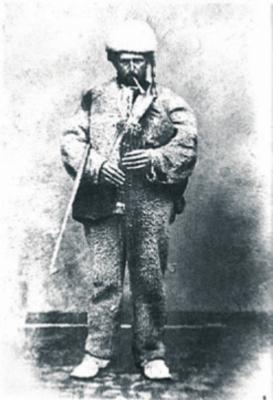
near Saint-Sauveur accompanied by some three muchosas. The group of pilgrims grew along the way and the delegation that joined in Velaines included at least another three muchards. They played with several together while stepping and also polyphonically. It was these muchards from Velaines who played best at the annually organised competition. There was also an annual pilgrimage to Oostakker, near Gent, which was also usually accompanied by three muchards.
Another fixture for the muchards was the Fiertel, the annual circumambulation on Trinity Sunday in honour of Saint-Hermes. The Ronsen people, who considered a pilgrimage to their own city too meagre a penance, had the opportunity to do penance anyway with this 35-km walk around the city. The tradition is still organised every year and ends with a procession in the town of Ronse. In 1885, during the Fiertel, shepherd Alphonse Gheux had his picture taken with his instrument in hand and all dressed in sheepskin. Alphonse Gheux was one of the last players, he played until 1912, when his muzelzak broke and the remains of the irreparable instrument disappeared into the bread oven.
The search for the third Musochá
In 1968, Hubert Boone, as a new employee at the Instruments Museum in Brussels (MIM), began cataloguing a very varied collection of folk music instruments. Much of it was a donation from the Snoeck family of Ronse. Notary César Snoeck had been an avid collector of musical instruments. Two of the most curious pieces in this collection were bagpipes, which seemed exotic at first sight.
Hubert Boone was therefore particularly surprised when he discovers these instruments to be of Belgian origin, coming from the village of Arc-Ainières, in the province of Hainaut. He decided, at his own expense, to investigate the matter more closely. Over several Saturdays, he takes his bicycle on the train to go and scout the region. He talks to older villagers, who were young when bagpipes were still played there.
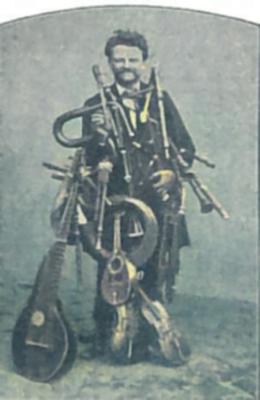
Hubert Boone asked about the Piron brothers, who were once the owners and players of the two instruments collected by Notary Snoeck, and today in the MIM in Brussels. It is Josephine Piron, the daughter of Thomas Piron, who speaks to him about Georges Gheux. Georges, she says, still played the bagpipes of his father, Alphonse Gheux, in his youth. Hubert goes to the Gheux family and they show him a photo of Alphonse, Georges' father, with his Muchosá. He is also told of one Charles Louis Lehon, a fellow shepherd of Alphonse, who lived in Popuelles. His eldest son had also started playing his father's instrument at the time. The instrument was bound to be found with Marcel, Charles-Louis' grandson, they said. Hubert Boone went in search of this grandson, who turned out to live in Escanaffles. Unfortunately, it was already late that Saturday, and Hubert had to hurry to catch the last train. A long time passes before he is able to revisit the region. He starts copying the Piron brothers' bagpipes, which are in the MIM. Soon he starts using them in his Folk Music Group ' De Vlier' and he makes some recordings with them.
Meanwhile, the results of Boone’s research were published and came to the attention of the Musée de la Vie Wallonne, which promptly launches a survey on the existence of the bagpipe in Wallonia. This survey finds hardly any interest in the region, except with the constable of Mourcourt, Mr Boucart. He takes the survey very seriously and goes to investigate Charles Louis Lehon's bagpipes. He finds the instrument at the shepherd's grandson, Marcel Lehon, at Escanaffles.
Boucart takes photographs of it, although he does not know enough about musical instruments to correctly assemble the individual pieces of the bagpipes.
Indeed, some drone sections and the blowpipe were missing as well as the bag.
Boucart tries to convince the shepherd to hand over the instrument to the Musée de la Vie Wallonne in Liège. Marcel pertinently refuses. After all, he remembers very well that the same policeman, Boucart, had fined him for not mowing the thistles in his field in time!
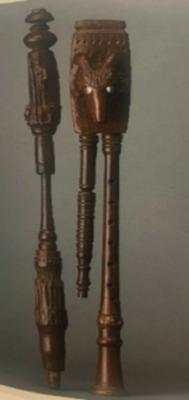
Finally, a third researcher hits the trail to the bagpipes. It is Remy Dubois, today one of the most respected makers of bagpipes. He lives in Verviers, but his family is actually from Kain, near Tournai. In conversation with Marcel Lehon, he mentions his grandfather at Kain and Marcel is proud to have known him as a teacher in his youth. It was getting late, that day, and it was already a little too dark to take good pictures. Remy asked if he could take the instrument with him to take decent studio photos, to which Marcel replied, " Puisque tu es de la région, tu peux l'avoir". (Since you’re from the area, you can have it.) This was just in time!
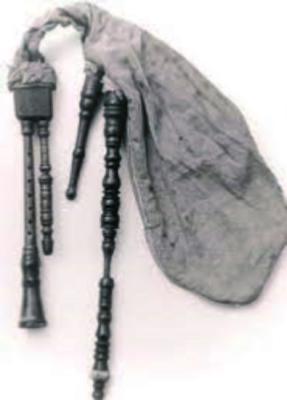
The instrument had always been kept in the drawer of a Picard-style cabinet, which Marcel had planned to sell the following week to his cousin, who had a bric-a-brac shop in France. Possibly, Popuelles' bagpipe had remained in it for sale and would thus have found its way, or its end, in France. The instrument was later transferred to the MIM in Brussels.The stock for the chanter and small drone is decorated with a ram's head and the large drone is decorated with carvings depicting a shepherd with sheep and dog, the inscription SAINT DRUON A SBOURG NÉ A CALVAIN PINOI and the chapel of Moustier, near Frasnes-lez-Anvaing. At the bottom of the drone are further notches, FAPxNART A MOUSTIER. As usual, this is probably the builder: Frabriqué par Nart à Moustier.
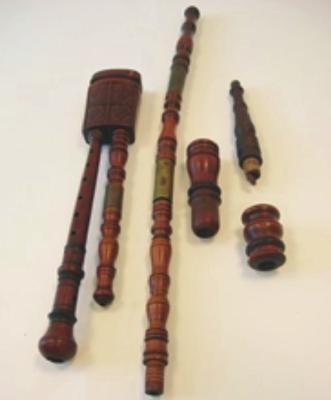
A Cornamuse à la David Teniers or a Muzelzak in Bruges, 1909?
In the book Doedelzaktraditie, printed in Belgium, I came across a postcard, dated 1909, with a black and white image of a blind Bagpiper in a market scene, probably in Bruges. The work is called ‘Au pays Flamand, l'Aveugle’.
Why do I think it is Bruges? The artist, Georges Hippolythe Dilly, (Lille 1874 - Châtel-Guyon 1941), is from Lille in northern France but he had in-laws living in the Bruges area and many of his paintings are images of the Bruges city centre. The painting shows a blind bagpiper and whilst the setting is a bit vague but, as is often the case with fine artists, the musical instruments are depicted in great detail. However, there is no immediate marketplace in Bruges with such a row of houses or a plump church tower in the background.
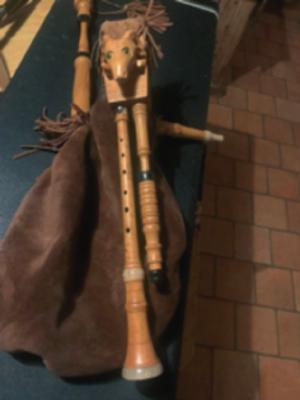
But this row of houses does exist and Dilly had already painted it once, also in 1909. The work is called ‘Les Vieilles Lucarnes de la Ruelle’ and it features the Lange Raamstraat, with the Saint-Gilles church tower in the background. The young lady looking back at the blind man can also be seen in another painting by Dilly. There she sits on a flat boat on the canals, shoulder to shoulder with a young man playing a Lichterveld accordion. So, the market scene could have been inspired by an existing Bruges market square, with a different row of houses. Looking now at the blind man's instrument in detail, we see two parallel drones lying on the shoulder. There is a leather pouch under the right arm, that’s not what we would expect. But we don't see a blow-in pipe, though there is a leather strap on the back, meaning that possibly the blind man was playing with bellows. Below the right hand we see a ring, metal or horn, possibly a ring/ferrule at the top of the bell joint. Or it could be the lower ring of a small drone, next to the chanter. We would also expect that small drone to be found on the left, but the leather bag was also on the right, it is actually possible. This could then be an instrument with three drones.
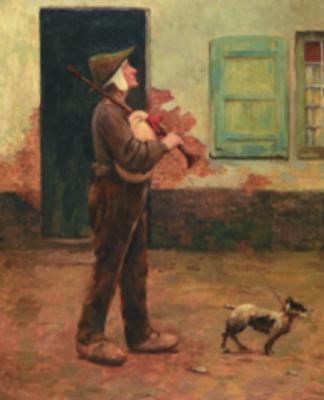
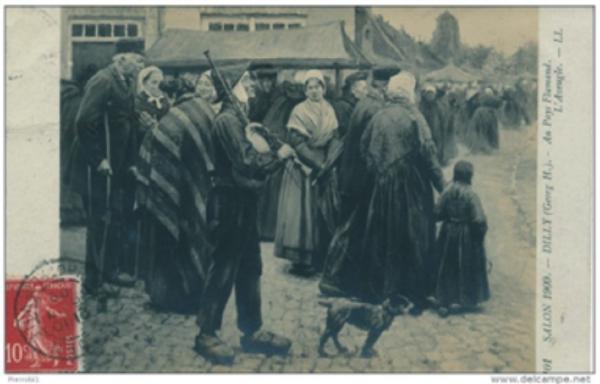
More clarity came when, in October 2022, I found another painting by Dilly on an internet art auction site, showing the same blind player in a rural village setting. On investigation, the work was sold in August 2021 I been unable to trace its whereabouts.
But this painting clearly shows only a single drone on the shoulder, and the spot under the left hand betrays even more than in the market scene, a ring of a small drone next to the chanter, so here it does clearly show a muzelzak, which apart from the bellows, fulfils the characteristics put forward by Marin Mersenne and Joost Verschuere Reynvaan.
My thoughts are that this latest discovered work by Dilly is older. The work Au Pays Flamand, l'Aveugle is a more sharply finished painting. The setting may be vague, but the characters and musical instrument are rendered in great detail. He has already used most of the elements in earlier paintings. As the work was destined to participate in the Salon de Paris in 1909 as part of his Au Pays Flamand series, he enriched the blind man's instrument with a second drone on the shoulder. No doubt he had seen this in old Flemish masters such as Jordaens and Teniers and thus wanted to make the instrument look more Flemish. If this is correct, then we can assume, judging from the dimensions and structural details of the bagpipe in the oldest painting, that the blind man was actually playing on a muzelzak. That on this work we also suspect a bellows instead of a mouth-blown instrument need not be a problem. Indeed, the blind man may have been forced, say, by defective teeth, to adjust his muzelzak. It was, after all, about his livelihood.
Two blind muzelzakplayers in Bruges.
On the Internet site Erfgoed Brugge, (Bruges Heritage), while searching for the facts surrounding Dilly's work, I found, among other things, a story from 1883 about two Bruges blind bagpipers. It is about Anselmus and Blind Cent, who were able to make a living with their bagpipes. They busked in markets and squares and they were asked to play for parties and were welcomed to play in Bruges’ pubs. They were very well matched and had quite a bit of success. One of the pubs where they regularly played was Herberg Den Engel, in Loppemstraat, off Simon Stevinplaats. The story goes that their close friendship was put to the test by a rich man who rattled his money but ended up not throwing it in the blind man's hat. One blind man suspected the other of wanting to keep the money for himself, whereupon they attacked each other with their instrument and smashed it on each other's heads. Both had thus deprived themselves of their livelihood. The rich man felt guilty and promptly ordered two brand new bagpipes from an instrument maker. The new instruments were of better quality than their previous ones, making them play even better than before. So much for the story but it raises a number of questions for me. Were there any instrument builders who could make bagpipes at that time? Maybe so, as there were certainly builders who made clarinets and oboes, and for a procession at Mechelen in 1913, bagpipes were especially made by a renowned instrument builder. That bagpipes were played in and around Herberg de Engel in Bruges may not have been entirely made up.
I even briefly considered the idea that one of the blind beggars could have been ’l'Aveugle’ by Dilly and the market square the Simon Stevinplaats, where Herberg Den Engel was around the corner in Loppemstraat. But, in the
story, both blind people had already died by the time the article went to press in 1823. Unless, of course, the painter Georges Hippolythe Dilly knew the story and was inspired by it to compose his work. Perhaps, like the Brussels painter Jean Carolus or the Abraham brothers and David Teniers, he also owned a bagpipe, which he could use for his paintings. The muzelzak on which the blind man is playing has a wide bell that does look very much like Joannes Stéphane Petyt's instrument. Is it this instrument that was offered for sale by a market vendor at the Marché au Puces in Paris half a century later? But those are very wild suggestions…
Afterword
It has been difficult to trace how the Muzelzak/Muchosá sounded at the time. Of the three instruments kept in the Brussels Instrument Museum (MIM), none have the original reeds. Only in the last decade has Remy Dubois managed to match exact replicas of the chanter with reeds of his own design that can offer a nearly correct tonal scale, albeit with uncomfortable fingering. As a result, we can now enjoy this exceptionally beautiful lilting timbre of the Muzelzak/Muchosá.
Now very recently, after months of searching for the right reeds, bagpipe maker Geert Lejeune from Bruges has managed to make this instrument sound perfect with a standard fingering. He was also able to increase the range by 3 notes above the octave, without compromising the beautiful timbre of the Muzelzak, thus preserving the character of this instrument, which has its roots in the 16th Century. So, the instrument now has the technical capabilities of modern Flemish pipes or a French Musette du Centre whilst retaining the authenticity of the old Muzelzak. It can be debated whether the instrument used to have these technical capabilities or not.
Regardless of whether that is relevant now for those who want to make music with this instrument, I assume that the instrument did have those capabilities. To begin with, the instrument was listed in two music encyclopedias of their time, that of Marin Mersenne in 1636 and that of Joost Verschuere Reynvaan from 1795. This allows us to assume that it was a fully-fledged musical instrument. Reynvaan, by the way, provides a tone scale that clearly indicates 3 notes above the octave and also the fork fingering to play half notes. From testimonies during Hubert Boone's fieldwork with people who had heard players before World War I, we know that they played polyphonically and sounded beautiful. We don't have to take anything away from the knowledge that instrument makers had, nor from the talent that players had at the time. It is enough to look at now living traditions in Eastern and Southern Europe. The ingenious system that kaba gaida makers have used for centuries to make their instrument play chromatically, the accuracy with which shepherds in Sardinia can make a prefect-sounding launneddas out of reed cane with a pocket knife, or in Sicily the friscalettu. We can safely assume that musicians and makers went out of their way to make music sound beautiful. We can do an instrument like the Muzelzak no greater honour than to choose a copy with the most beautiful sound and the widest technical possibilities. Only in this way does the Muzelzak/Muchosá still have a future outside the walls of a museum.
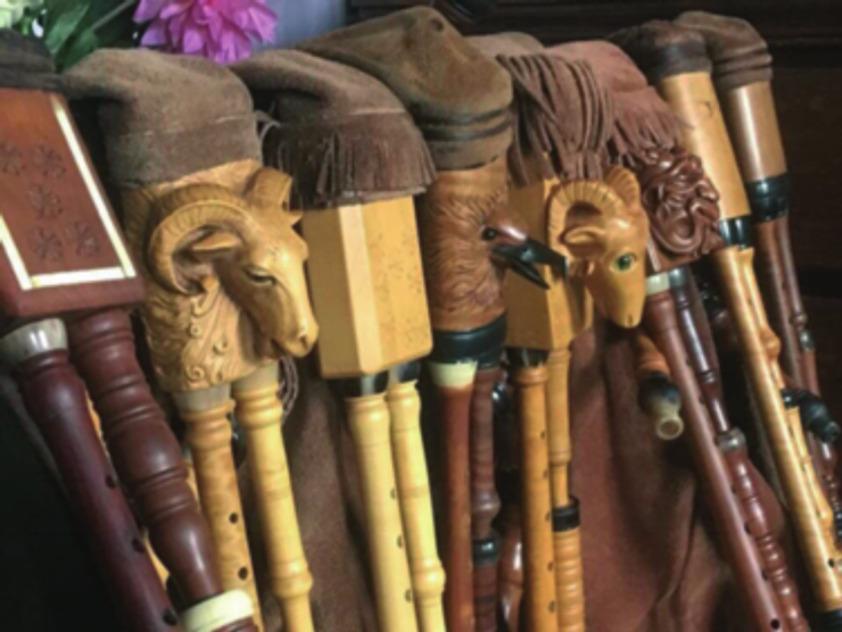
Sources :
Harmonie Universelle, Marine Mersenne, 1636
Muzijkaal Kunstwoordenboek, Joost Verschuere Reynvaan, 1795
De Vriendschap in twijfel gebracht, Het
Burgerwelzijn, 23 juni 1883 – Erfgoed
Brugge
Archives du Folk 59, Patrice Gilbert 1992
Archives du Folk 59, Patrick Delaval, 1996
Archives du Folk 59, Christian Declerck,
2014/2021
La Muchosá, Cornemuse du Hainaut, Dr.
Jean-Pierre Van Hees,l’Anuario da Gaita,
2007
Doedelzaktraditie in België, Hubert Boone,
Renaissance du Livre, 2013
Un Infini Sonore, Jean-Pierre Van Hees,
Editions Coop Breizh, 2014
Belgische Super Eeuwelingen, blogspot
Noel Demeyt, 2018
Special thanks to
Dominique Vandamme, Olle Geris, Remy Dubois, Hubert Boone, Jean-Pierre Van Hees, Patrick Delaval, Jean-Michel Renard, Stef Boone, Jean-Marie Van Coppenolle, Patrice Gilbert, Alex Calmeyn, Chabier Aparizio, Martin Rusek, Wim Bosmans.
- Data Processing Notice (GDPR)
-
@BagpipeSociety on X (formally known as Twitter)
-
TheBagpipeSociety on Instagram
-
 BagpipeSociety on Facebook
BagpipeSociety on Facebook
Something wrong or missing from this page? Let us know!
